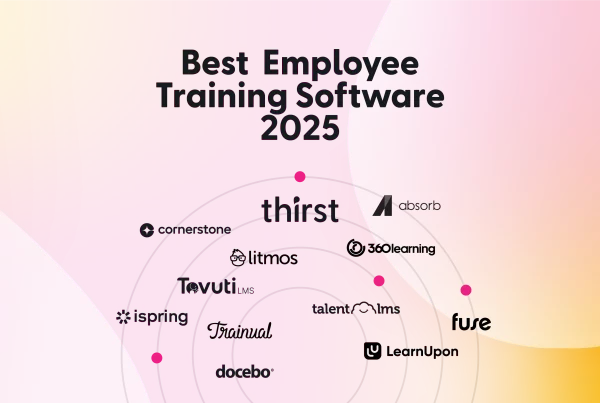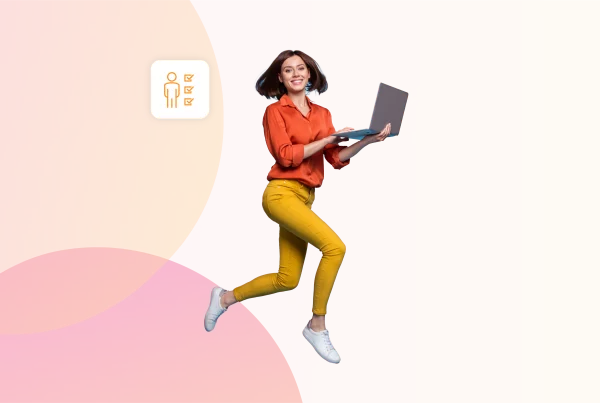Time flies when you’re having fun, and as we approach the threshold of 2024 (Really?!), we can already foresee that the learning and development space is unsurprisingly set to undergo many transformative shifts, with plenty of innovation taking centre stage over the course of the next 12 months. 💭
The coming year promises a dynamic journey for both organisations and individuals committed to continuous learning, from integrating cutting-edge technologies to redefining traditional and old-hat ways of learning.
So if you’re curious to learn more about the key trends shaping our industry, keep on reading as we delve into the 11 L&D trends poised to shape the educational landscape in 2024, offering insights that will empower businesses and learners alike to navigate the exciting path ahead. 🗺️
If that sounds good to you – Let’s jump right in! 👇🏼
1. AI Automation in the Workplace 🤖
It’s probably no surprise to find AI Automation leading our list, given the undeniable impact of AI technology reshaping numerous industries in the past 12 months alone.
But don’t just take our word for it…
Research by Gov. UK reported that: “AI contributed £3.7 billion to the economy in 2022!” And according to 2023 data from Forbes: “68% of large companies, 33% of medium-sized companies, and 15% of small companies have recently incorporated at least one AI technology”.
In 2024 and beyond, the influence of AI automation in the workplace will undoubtedly continue to impact the learning and development community significantly, reshaping the dynamics of skills development and professional growth.
“Artificial intelligence will continue to streamline routine tasks, and the learning and development sector will witness a surge in demand for training programs that equip individuals with critical thinking, creativity, emotional intelligence, and complex problem-solving skills.…All of these machines cannot (yet) replicate. 🖥️ 🧠”
Moreover, AI-driven personalisation of learning experiences will become even more sophisticated, further tailoring educational content to individual needs and learning styles.
And while there’s no getting away from it, automation may render some roles obsolete; the positive news is that it will simultaneously create new opportunities, prompting all of us in the learning and development community to adapt swiftly to these changes and play a pivotal role in preparing the workforce for an AI-driven future.
Why not choose Thirst as your AI learning platform of choice in 2024?
2. Learning in the Flow of Work 🚰
Traditionally, workforce training took people away from their desks and office spaces. In 2024, learning in the flow of work remains poised to undergo a transformative evolution with technology at its core.
How so, you may ask….
Well…Intelligent learning systems powered by AI will actively identify teachable moments and deliver targeted, just-in-time content to address specific challenges or opportunities.
No more time needed away from the office for training. 👨🏻🏫
Microlearning modules that are accessible on-demand will offer quick and digestible bursts of information, allowing employees to acquire knowledge efficiently without disrupting their workflow.
Immersive technologies, such as augmented reality (AR) and virtual reality (VR), will also play a more prominent role in creating realistic and context-rich learning experiences within the flow of work.
Discover our recent guide on the importance of learning in the flow of work for L&D.
3. Diversity, Equity, and Inclusion (DEI) Training 🏳️🌈
Just half a century ago, the idea of Diversity, Equity, and Inclusion in the workplace was virtually nonexistent. Thanks to persistent advocacy and civil rights efforts, some of which continue to this day, things are changing… slowly.
According to research by Linkedin... “76% of employees and job seekers said diversity was important when considering job offers. 60% of employees want to hear business leaders speak up on diversity issues, and 80% of survey respondents said they want to work for a company that values DEI issues”.
DEI training in 2024 will continue to evolve to meet the changing needs and expectations of organisations and employees though it will be more personalised, technology-driven, data-informed, and culturally aware, reflecting a commitment to building diverse, equitable, and inclusive workplaces.
Let’s take a further look. 🔬
Customised and Inclusive Content ✅
DEI training programs will become more tailored to different organisations’ specific needs and challenges. They will strive to be more inclusive by addressing a wide range of diversity dimensions, including race, gender, sexual orientation, disability, and more.
Cultural Competency Training ✅
DEI training will include more comprehensive cultural competency components, helping employees understand and appreciate their colleagues’ and customers’ diverse backgrounds and experiences.
Inclusive Leadership Development ✅
Leadership development programs will place a greater emphasis on inclusive leadership skills. Leaders will be trained to create inclusive environments, recognise unconscious bias, and champion diversity and equity within their teams.
Partnerships and External Resources ✅
Organisations will increasingly partner with external diversity and inclusion experts and organisations to enhance their training programs. Leveraging external expertise can bring fresh perspectives and best practices to DEI initiatives.
Measuring Impact ✅
Organisations will focus not only on the quantity but also the quality of DEI training. They will measure the impact of DEI initiatives not just in terms of training completion rates but also in terms of tangible changes in workplace culture and behaviour.
Legal and Ethical Considerations ✅
DEI training will need to stay current with evolving legal and ethical standards. This includes addressing issues related to privacy, data security, and compliance with anti-discrimination laws.
4. Continuous Learning Culture & Organisational Agility ♻️
2024 will see a more considered integration of continuous learning and organisational agility into the DNA of successful businesses. This shift reflects an understanding that adaptability and a commitment to lifelong learning are critical components of sustainable success in a rapidly evolving landscape.
Microlearning at Scale 🧑🏾🏫
The trend of microlearning, providing bite-sized, easily consumable learning content, will continue to grow. This approach aligns with the demands of a fast-paced work environment, enabling employees to acquire knowledge without significant disruptions to their daily tasks.
Skill-Building for the Gig Economy 💻
Given the rise of the gig economy and remote work, continuous learning will focus on equipping employees with the skills needed for the evolving nature of work. This includes digital skills, remote collaboration, and adaptability in project-based environments.
Just-In-Time Learning Resources ⭐
Learning content will be increasingly available on-demand, allowing employees to access relevant information exactly when they need it. This just-in-time learning approach supports problem-solving in real-time.
Employee-Driven Learning Paths 🛣️
Organisations will empower employees to take ownership of their learning journeys. This includes providing tools for self-assessment, goal setting, and creating personalised learning plans aligned with career aspirations.
Agile Methodologies in Learning Design 🖌️
The principles of agility will be incorporated into the design and delivery of learning programs. Learning and development teams will adopt agile methodologies, allowing for quick iterations and responsiveness to changing business needs.
5. Reskilling and Upskilling for the Future 🆙
To recap. Upskilling is about helping employees learn the skills that will allow them to progress in their current roles. Reskilling is about helping employees learn the skills that will allow them to move into a new role.
Reskilling and upskilling in 2024 will be underpinned by three factors:
- Agility.
- Personalisation.
- A forward-facing approach.
Organisations will need to recognise the strategic importance of continuous learning to navigate the challenges and opportunities presented by the dynamic and evolving job market.
9 drivers for reskilling and upskilling your workforce in 2024
- A focus on Digital Skills ✅
- Personalised Learning Paths ✅
- Gamification and Immersive Learning ✅
- Using Lifelong Learning Platforms ✅
- Soft Skills Development ✅
- Data-Driven Skill Assessments ✅
- Flexible Learning Formats ✅
- Inclusive Reskilling Initiatives ✅
- Employee-Driven Learning Plans ✅
Discover Upskilling and Reskilling: Why it is the Future of Work.
6. Wellness and Mental Health Support 🧠
According to data from The Mental Health Foundation, “1 in 6.8 people experience mental health problems in the workplace.” not least, “better mental health support in the workplace can save UK businesses up to £8 billion annually”.
In 2024, the pressure on organisations to provide more appropriate and impactful wellness and mental health support will be even more prevalent.
By addressing the well-being of employees, organisations can create environments that foster engagement, productivity, and a sense of fulfilment, contributing to both personal and professional growth.
Here’s a quick list of the areas in which you can make a meaningful and positive impact within your organisation.
- Holistic Employee Well-Being Programs 🗣️
- Mindfulness and Stress Reduction Training 😞🙂
- Emotional Intelligence Training 🧑🏽
- Mental Health Awareness Training for Managers 👔
- Flexible Work Arrangements and Learning Opportunities 📅
- Integration of Mental Health Apps and Platforms 📱
- Wellness Days and Mental Health Leave Policies 🌳
- Peer Support Networks 🫂
- Regular Mental Health Check-ins 🧠
7. Generative AI Skills 🤖
We touched upon AI from a more general standpoint earlier in the article; however, you may be curious to learn about Generative AI, which is a type of artificial intelligence technology that can produce various types of content, including text, imagery, audio and synthetic data.
Here are some of the key trends within this space that could form part of your organisation’s L&D innovation plan in 2024…
Enhanced AI-Enhanced Content Creation ✅ 🖱️
Generative AI will play a significant role in content creation for learning materials. AI algorithms will assist in generating realistic and context-rich scenarios, simulations, and interactive content, enhancing the quality and effectiveness of learning materials.
Creation of Simulated Learning Environments 👩🏽🏫
Advanced Generative AI will contribute to the creation of highly realistic simulated learning environments. This allows learners to practise and apply skills in virtual scenarios closely resembling real-world situations, enhancing the transferability of knowledge.
AI-Driven Skills Assessment and Certification 🏆
Generative AI will be employed in developing sophisticated skills assessment tools. These tools can evaluate not only factual knowledge but also higher-order skills such as problem-solving, critical thinking, and creativity. AI-driven certification processes may become more common.
AI for Personalised Skill Recommendations ✅
Generative AI will analyse individual skills, preferences, and career aspirations to provide personalised recommendations for skill development. This contributes to a more targeted and efficient learning experience.
AI in Collaborative Learning Environments ✅
Generative AI will support collaborative learning by facilitating group projects, discussions, and problem-solving exercises. AI algorithms can analyse group dynamics and provide insights for improved teamwork and communication.
Continuous Learning through AI-Assisted Feedback
Generative AI will contribute to the continuous learning loop by providing real-time feedback on performance and suggesting areas for improvement, creating a dynamic and responsive learning environment.
If you like the sound of what you’ve just read, did you know
Thirst can help you with all of this and more?
8. Personalised Learning Experiences for Employees 🧑🏽👩🏼
Personalised learning experiences in 2024 will be underpinned by a combination of advanced technology, learner autonomy, and a focus on the individual needs and aspirations of employees.
Microlearning for Personalisation 🌟
The trend of microlearning, delivering small, focused learning units, will continue to support personalisation. Microlearning modules can be customised to address specific skill gaps or provide just-in-time information, aligning with the learner’s immediate needs.
Multi-Modal Learning Experiences 🎙️
Personalised learning will extend beyond traditional formats. Employees will have access to a variety of learning modalities, including video tutorials, interactive simulations, virtual reality (VR), podcasts, and more, catering to diverse learning preferences.
Gamification for Engagement 🎮
Gamification elements will be strategically integrated into personalised learning experiences to enhance engagement and motivation. Badges, rewards, and interactive elements will make the learning journey more enjoyable and rewarding.
9. Soft Skills Development 🫶
Soft skills development over the next 12 months will be characterised by a holistic and adaptive approach, leveraging technology, data, and a focus on practical application.
The goal will be to equip employees with the interpersonal skills needed to thrive in diverse and evolving work environments.
Emphasis on Emotional Intelligence (EI) ✅
- Soft skills training will place a heightened emphasis on emotional intelligence, including self-awareness, empathy, and effective communication.
- Organisations will recognise the impact of EI on collaboration, leadership, and overall team dynamics.
Leadership Development with a Focus on Soft Skills ✅
- Leadership development programs will place a strong emphasis on soft skills.
- Leaders will be trained not only in technical competencies but also in the ability to inspire, motivate, and lead teams effectively.
Resilience Training ✅
- Soft skills training will address crisis response and resilience.
- This includes developing skills to navigate uncertainty, manage stress, and maintain a positive and resilient mindset in challenging situations.
Incorporation into Performance Management ✅
- Soft skills development will be integrated into performance management processes.
- Managers will provide feedback on soft skills, and employees will have clear expectations for the development of these skills as part of their professional growth.
Take a look at Hard Skills vs. Soft Skills. The Main Differences
10. Broader Use of Learning Experience Platforms 🖥️
The broader use of Learning Experience Platforms in 2024 will blend advanced technology, personalisation, collaboration, and a focus on continuous improvement.
As organisations prioritise employee development and agility, LXPs like Thirst will play a pivotal role in creating effective and engaging learning ecosystems.
Content Curation and Personalisation 🧑🏽
LXPs will feature advanced content curation capabilities, allowing organisations to curate and organise learning content from various sources. Personalisation algorithms will help deliver curated content based on individual learner profiles.
Collaborative Learning Features 🧑🏻🤝🧑🏻
LXPs will foster collaboration and social learning. Features such as discussion forums, social feeds, and collaborative projects will be integrated to encourage learners to share insights, discuss topics, and collaborate on projects within the platform.
Rich Multimedia and Interactive Content 🧪
LXPs will continue to support rich multimedia content and interactive learning experiences. This includes video-based learning, simulations, virtual labs, and other interactive elements to enhance engagement and knowledge retention.
11. Data-Driven Learning & Development 📈
In 2024, there will be an even deeper integration of analytics into every aspect of the learning journey.
This data-driven approach aims to enhance the effectiveness of training programs, empower individual learners, and align L&D efforts with broader organisational goals.
Here are some of the key benefits…
1. Predictive Analytics for Skills Forecasting: Organisations will use predictive analytics to forecast future skill needs. By analysing current and emerging trends, organisations can proactively identify the skills that will be in demand, informing the development of targeted training programs. 📉
2. Learning Impact Measurement: Organisations will focus on measuring the impact of learning initiatives on business outcomes. Metrics such as improved job performance, increased productivity, and reduced turnover will be used to assess the effectiveness of training programs. 📊
3. Integration with HR Systems: Data-driven L&D will be closely integrated with HR systems, allowing for a seamless flow of information between learning platforms and other HR functions. This integration supports better talent management, succession planning, and workforce development.
4. Learning Analytics Dashboards: Advanced analytics dashboards will become standard in learning platforms. These dashboards will provide visual representations of key learning metrics, enabling L&D professionals to quickly assess the effectiveness of programs and identify areas for improvement. 🗃️
Phew! That was a long one.
We hope you have garnered some new insights into what 2024 may hold for the learning and development industry! 🏆
Did you know that Thirst can help your organisation stay ahead of the curve for the year ahead and beyond?
We are already putting into practice many of the things we’ve touched upon here.
Thirst is the learning and knowledge platform that your employees will want to use – we have the perfect solution as our LXP prioritises personalised, engaging, and user-driven learning experiences.
Thanks to a mobile-first dedicated portal, employees can now access insights, resources, and company-wide expertise effortlessly, enabling them to build on their skills to learn faster and smarter.
Additionally, Thirst assists in identifying knowledge gaps among individuals and teams, resulting in more thoughtful and precise outputs from your team. 👌
Over 100 L&D teams trust Thirst to support knowledge sharing within their organisation. 🫶
Want to try it for yourself? 🙋♀️
Get a free 1:1 demo of the Thirst platform now.
For more e-learning insights, resources and information, read the Thirst blog…
LXP vs LMS: What’s the Difference? (2024 Guide) | How to choose a learning platform for your organisation | 7 Ways to Build a Lifelong Learning Culture that Drives Employee Growth







